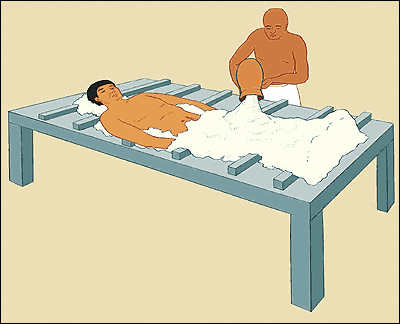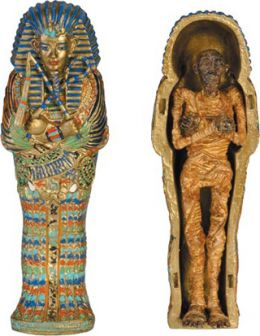Mummification was a sophisticated process of preserving dead bodies of both animals and human beings. This process was ritually done in Egypt. Mummies were preserved corpses and were specifically protected from decomposition. Hence, they retained their natural physical form. The most suitable way of preserving these dead bodies was mainly through mummification.
The latter method came into existence during ancient years and was part and parcel of Egyptian socio-cultural civilization. The main rationale behind mummification was to countercheck increased raiding of tombs. Meanwhile, this act was considered to be the most integral ritual of preparing individuals for life after one has died. It is imperative to note that the process of preparing mummies was multifaceted, expensive, and bounded by rituals and ceremonies.
Fundamental nature of mummification
It is evident that Egyptians believed in life after death. They also understood that the elements of the soul were non- perishable and hence it was not advisable to bury a dead body without carrying out a cl4eansing process that would see the new being transcend into eternity. In addition, Egyptians believed that both animals and the human soul were inseparable from the rest of the body. Moreover, they had a perception that every individual had three souls, namely Ka, Ba, and Akh (Lawrence 364).
They believed that if they did not mummify the body, Ba would leave the grave and haunt the family of the departed even while in their mortal world. In this case, they preserved the dead bodies to ensure that they are prepared for eternity. Besides, the bodies were vital for ancient Egypt’s afterlife since they helped to keep the soul alive. Research done indicates that Egyptians believe that if they do not preserve the body, the soul might not get back after the resurrection (Museum of Science par. 3). In line with this, there was an illusion that mummified bodies offered a vacuum for the persona’s spirit to occupy, especially after death.
What made mummification a ritual?
It is vivid that Egyptians held a strong belief that they were on a journey to another world where they would lead a new life (Perry194). Although they lived ravishingly in Egypt, they felt that they would require basic necessities to use after departing to the new world. In line with preserving the deceased, various substances needed for daily use such as food, clothes and weapons were put in graves alongside the deceased person. Moreover, they believed in several aspects that were indispensable to human life. Such include the physical body, shadow, name, personality, immortality, and soul (Perry 193).
The Egyptians felt that such practices were important in the well being of every individual in the sense that they played a vital role in reincarnation into the afterlife. The fact that such practices were integral in an individual’s life made Egyptians use the mummification platform to assure those who had departed a successful and more prosperous life into the next world. For this reason, mummification was not only a long process but also entrenched with mysterious spells and enthralling rituals. Apparently, this process was fundamental right from the ancient dynastic period in Egypt to present times (Perry 191).
How mummification is done
When an individual died, the Egyptians, preferably those from the deceased family, went into a mourning period. They later took the dead body to a priest who was supposed to embalm it. They negotiated over the cost for the mummification process so that it could be done in due time. The process of mummification was purely religious, and as such, it was done with much care amid the strict procedure. It was against this reason that it was conducted by priests who had been trained in both skills and religious rituals that were associated with mummification (Dawson 41).
Other people who were involved in the process included the cutters and scribes. In this case, the scribe’s role was to watch over the incision of the body that was conducted by the cutters. This act was conducted near the site where the tombs were located. Meanwhile, the ritual practice passed through a series of steps before it got into completion (Museum of Science, par 1). In all the different stages of mummification, they were followed by ritual practices until the mummies were prepared for completion.
However, it is worth to note that mummification has evolved from simple to a more complex process with time. Needless to say, this has led to more time being taken to carry out the process fully. For instance, it may take up to 70 days to complete a single mummification process since it has to be done with great perfection. Within the 70 days duration, the process of purification was ritually meant to correspond to the length of time taken during which the Dog Star appeared (Lawrence 363). This applied to all corpses regardless of social status. In the meantime, the process of making the mummies was scheduled into three sessions. The first 15 days were spent on cleansing and purification of the body, and after that, the drying period consumed forty days. The final procedure of wrapping and bandaging took 15 days.
Besides this, several tools were used by the embalmers in the process. Such tools included knives, tweezers, and needles, and bronze that was used in opening up the corpses (Dawson 41). Evident from research indicates that some tools were left inside the corpse during mummification. In addition to this, the whole act of mummification was performed on a slanted table to facilitate the blood and fluids to drain easily in a built-in tank. Apparently, from the study done on ancient mummies, it is evident that the mummification process was highly scientific in nature. All the steps followed during the procedure had a scientific aspect behind them.
Initially, the body is cleansed with water and then anointed with oil for purification. Moreover, the embalmers dissect the abdomen to empty the stomach, where several organs are removed. Worthwhile, the internal organs, including the lungs and intestines, are removed, leaving behind the heart (Dawson 44). The Egyptians believe that, by leaving the heart behind, it would testify for the dead beings after the resurrection. For this reason, the good-luck charm is placed over the heart to guard its expedition through netherworld (Museum of Science, par 5).
Additionally, the brains were liquefied and emptied through the nostrils. To elaborate more, a horny tool was injected into the brain through the nostrils and swirled to liquefy the brain. Philosophers account that, the horny tool was inserted in a thin hole known as ethmoid bone slightly above the nose (Dawson 45). This was used to extract the brain in conjunction with a hooked bronze needle. Needless to say, it was hypothesizing how the embalmers were able to extract such a massive organ through the nostrils. Moreover, the head was bent forward to empty all the stuffing in the skull through the nose.
It is vivid that the greater part of the Egyptians mummies had their brains left in place and was dried and shrank up to the period of mummification. In order to avoid the brain from crumbling, some form of oil substance was used. This was necessary since the whole process of preservation was deemed to be important (Dawson 45). In line with this, having emptied the skull, the body was ready for the next step of mummification.
Imperatively, the embalmers desiccated the body by dehydrating it using salt. Often, the body of the deceased was soaked in a mound of natron salt from the local area (Dawson 45). Finally, other preservatives are poured into the body for preservation.

This was done and waited for a few days to allow the salt to absorb all the moisture; hence the body shrank and darkened fully. It is worth to note that, in recent times, mummies are dehydrated by the use of baking powder as opposed to the past days. Other anti-microbial agents were used along with the salt to desiccate the body. Such include cassia, resins, myrrh, and palm wine. These embalming agents were vital in protecting the body from decaying prematurely (Dawson 46). According to research conducted on ancient mummification, it is evident that the mummy’s head was made darker than the entire body by wrapping it all over with linen soaked in resin.


Along the mummification process, embalmers dry the lungs, intestines, liver and the stomach. They then put the content in canopic jars that are normally put in a set of four (Dawson 46). To emphasize this, the jars were predestined to serve an emblematic purpose in the deceased’s burial. After dehydration, the corpse was washed with clean water and anointed with oils, incense, and herbs. Besides this, during the mummification process, the mummies were finally sealed with several catacombs soaked in resins, which acted as the final resting place of the dead body (Museum of Science par 7).
Such sewn bandages were used to bind the boundaries. In most cases, sawdust, ash, or salt was crammed in the body to make it compact. During the final stage, amulets containing magic spells were interleaved in the layers of bandages. They were meant to lend a hand to the deceased body in the trials and tests which he would face in the new world. Later on, the mummy was laid to rest in a tomb.

According to Taylor (2), Egyptians were best known for the captivating ideologies they employed toward the mysteries of death and resurrection. It is evident from the collections found in British museums.

There has been enough evidence on the famous collections of Egyptian mummies that accessibly account for the Egyptians’ beliefs of the afterlife. Moreover, such collections illustrate how the Egyptians responded to challenges that imposed the beliefs. In this book, the author illustrates that Egyptians made copious necessities on behalf of the deceased (Taylor 15). Several issues that were put into considerations include embalming and mummifying sacred animals and dead bodies. It is believed that Egyptians prepared a perilous journey for the deceased toward the realm of their gods.
It is vivid that Egyptians were more interested in taking care of their dead more than they were engrossed in architecture. John Taylor asserts that extra rituals were performed to the sacred animals and dead bodies before preparing for their final departure into eternity. Moreover, this author exposes the secrets behind the ritual performed at the end of life on earth. From his analysis, he confirms that mummification is traditional (Taylor 3). Moreover, it is legendary and mythical in Egyptian history hence linked to particular gods in Egypt, particularly Osiris. Mythically, the Egyptians believed that their god, Osiris, was murdered by his younger brother Seth out of jealousy. However, his wife, Isis, brought him to live within a day. During this time, Osiris’s body was embalmed by the Anubis, who was one of the Egyptian gods.
The god of Anubis was from that time associated with the embalming of the mummies; hence he became the god of mummification. Since this time, mummification became common in Egypt (Taylor 113). Unconfirmed facts have it that Egyptian’s ways of preparing mummies varied in accordance with the social status of the departed individual. Ancient mummification practice was carried out to the Pharaohs only (Mummification Picture 3). Some of the local people who were deemed to be wealthy were also included in this ritual as time went by since they were able to cater for the cost of the process.
Later on, peasants were also included in mummification once they died. In order to shed more light on this practice, though there came a time when everybody was embalmed, mummification varied in technology depending on the roles and wealth owned by individuals. In this case, there were different categories of mammies, namely the royals, middle-class mummies, and those of peasants. The royals comprised of pharaohs and his nobles who were highly valued (Taylor 13). To recap it all, it is imperative to note that the anonymity of Ancient Egyptians mummification has unraveled slowly over the past years. Due to this reason, the embalmers became selective in terms of art and processes of mummification (Lawrence 363).
Currently, modern techniques, rituals, and ceremonies have no accounts in relation to past processes. A comparative study from past documents reveals that the process of making mummies has mutated from tools, arts, and ritual ceremonies. Considerably, it is impossible to explain the process of mummification due too its gradual change. Nevertheless, the Egyptian mummification procedure still continues to be a mystery to many people. Insightfully, researchers have relied on only some depictions and fragments derived from ancient papyrus (Museum of Science, par 9).
Works Cited
Dawson, Warren. Making a Mummy. The Journal of Egyptian Archaeology. 13 (1927),40-49. Lawrence, Susan. Unraveling the Mysteries of the Mummies. Science News. 118(1980), 362-364.
Mummification Picture. Egypt Lecture. 2011. Web.
Museum of Science. Mummification in Ancient Egypt. 2003. Web.
Perry, James. The Cult of the Sun and the Cult of the Dead in Egypt. The Journal of Egyptian Archaeology. 11 (1925), 191-200.
Taylor, John. Death and Afterlife in Ancient Egypt. Chicago: University of Chicago. 2001. Print.